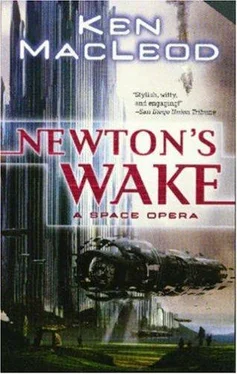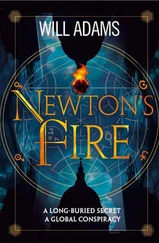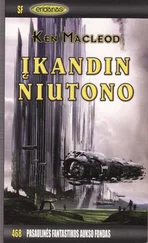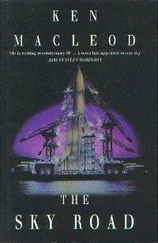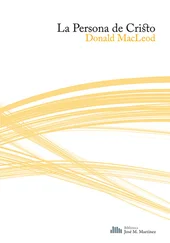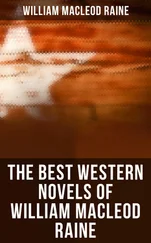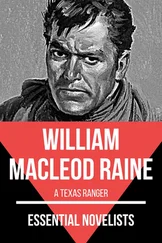‘Nothing like that,’ said Al-Khayed.
‘Go,’ Ben-Ami said, into a throat mike.
Above the back of the stage appeared a full-colour hologram of Earth. Blue and white, glimpses of continents in green and brown, with only the outlines of the landmasses to distinguish it from any other habitable terrestrial. That was enough: the Horn of Africa, the pinched lake of the Mediterranean were unmistakeable, iconic, burned into human memory since the classic Apollo 8 shot. Behind him Ben-Ami heard Winter’s indrawn breath. He smiled in the dark.
How do you show history, when all around you history is happening?
In the past few days Benjamin Ben-Ami’s gaze and attention had flipped repeatedly between his scenario slate and the news wall. There had been a moment when a news team had stopped and taken a panning shot down into a valley. There, on the South Continent, a few hundred kilometres from New Start, was a sight like nothing he had ever seen. The five kilometres visible had been transformed overnight, from fertile if wild and scrubby riverbanks to farmland: green replacing blue-green, fences and glass houses, evenly spaced knots of houses each with its own comms cluster and antiaircraft missile battery. It was as if a great carpet of farms had been unrolled down the valley, each farm almost identical with the others, and each bristling with self-defensive, self-sufficient individuality.
When he’d looked away, turned his gaze back to the street around the cafe before wrenching it again to his work, the same distraction had prevailed: strangers everywhere. A few were quiet, watchful, Asiatic-featured people in colourful clothes that distinguished even the men among them easily from the black-clad Knights. These were the ones Lucinda Carlyle had called ‘commies,’ the DK. There were far more of the ones she’d called ‘farmers’: adults in stiff, sweaty garb gaping and rubbernecking and talking loudly, children swarming everywhere, yelling and laughing, all suntanned skin and sun-bleached hair and screaming laughter and gappy white teeth. You would have thought the farmers would have had enough to do, what with their settlings and steadings, but no. They had time to spare for tourism and shopping. Tourism without tact, shopping without respect or reciprocity, slapping down their AO dollars as though doing the place a favour and departing with armfuls of stuff. And their faces, unoptimised, raw, unageing but stubbled and spotted, lined and furrowed. The commonest purchase, or loot, among the women was cosmetics, clothes a close second; among the men, deodorants and gadgets.
It had taken him a day to realise ways in which this invasion of the body-shoppers could be turned to the advantage, practical and emotional, of the play.
The hologrammed Earth turned; the orchestra, recorded for this rehearsal, struck up. Brassy, rythmic, with an underlying and increasing drumbeat. The Walker tanks shuffled into a ponderous dance, their treads rising and falling, their gun arms sliding back and forth. In step with the drumbeats they approached each other, feinted and fell back, time and again. Apart from the flags painted on their sides—the Stars and Stripes and the Circled Stars—they were indistinguishable, their movements mirroring each other.
A tall woman in a ragged floaty dress ran on tiptoe from the wing to centre stage, spotlit; stopped, faced the audience. Gwyneth Voigt, Eurydice’s top female solo singer. Her classically trained voice lavished itself, wasted on Winter’s lyrics:
Two empires walking blind to war:
USA and EUR!
Under capital’s eyes unblinking
workers trapped by their hoodwinking
sacrifice their lives unthinking
to giant lizards from another star!
And so on. It was a crude and didactic rant in rhyme, but the woman’s voice made the words sound eerily apt. The light and shade silhouetted the Walker tanks, making them look indeed like giant lizards, great skeletal tyrannosaurs that loomed and thrashed and never quite laid a blow on one another, until …
The hologram planet faded as the stage’s backscreen lit up with an equally iconic and familiar image, of rising rockets. Zoom and track to the star-circled flags on the missiles and on the British, French, and Russian submarines from which they were fired. Cut to mushroom clouds over the US launch facilities, then missiles rising from those the first strike had missed. A series of almost subliminally fast, cliched images: the Eiffel Tower, Big Ben, the Vatican, the Kremlin, each followed by a nuclear explosion. The hologram of Earth came back, this time a combined image from near Earth orbit: archived images from the real time, as the continents and seas sparkled with a thousand points of light.
Ben-Ami felt reasonably satisfied with this as a quick visual for the war. Showing how an American military AI had upgraded itself to consciousness and burned its way through the networks, then into the brains of people connected to them, had been more of a challenge. He’d had to rely on his audience’s prior knowledge of the Hard Rapture, but he still wanted to show it, at least symbolically.
Voigt fled the stage and the drumbeat deepened and quickened, and the lights faded: the war went on in the dark. When the lights came dimly back, after a moment of silent scurrying, two rows of green-glowing paper-thin screens with keypads had been laid on the floor. From each wing a dozen people in camo silks and dark shades ran on, formed up in lines and sat down cross-legged on the stage, facing each other across the banks of screens. Their fingers tapped at the keyboards. On the hologram the planet vanished to be replaced by gunner’s eye views of several heavy machine guns, whose bullets rapped out in time with the rattle of the keys—no particularly clever trick, since it was the same sound effect that did service for both. The operators sang instructions to each other, in English on one side, in French on the other. The guns darkened to sharp shadows, and behind them, filling as much space as the Earth had done, a sphere of light grew. It was a complex sphere, made up of many lines in many colours, that twined and slashed about like the sparks on a Van de Graaff generator. The light intensified, and the hologram drifted forward and expanded.
Suddenly, all the people on the USA side of the stage swivelled their screens and turned their heads to the audience at once, and—with a few exceptions that Ben-Ami mentally noted for later correction—each screen and each pair of shades reflected the swirling sphere above. The operators on the EUR side worked on, oblivious.
The American Walker tank changed too. With one tug of a hidden rope, it separated into its component parts. Each part sprang into a different self-sufficient shape: the turret and the cab, the guns and legs and treads each transforming into an autonomous war machine—some winged and remaining airborne, others sprouting new limbs on which they scuttled. A cloud of carbon dioxide swept across the stage, revealing a barrage of laser beams that struck the EUR tank and slashed across the faces and bodies of the EUR operators, who fell back writhing dramatically. The new war machines swarmed across the stage and pounced on the bodies and on the enemy tank.
The action speeded up, becoming intentionally more chaotic, the music more urgent and discordant: people and machines surged in from both sides of the stage, those on the USA side becoming caught up in the rainbow trance of the glowing sphere, those on the EUR side fighting and falling to the machines. Every so often a flashbulb flared, leaving afterimages through which what was seen on the stage became a glimpse of a memory you wanted to forget.
The lights went off. The hologram sphere expanded to fill the stage, then vanished like a popped soap bubble in sunlight. The music softened. When the lights slowly rose again the stage was filled with a massed choir. They wore academic robes over leotards. None of the singers was Eurydicean. There was something shocking and beautiful in the rank on rank of unoptimised faces and wildly variant heights and skin-tones.
Читать дальше
